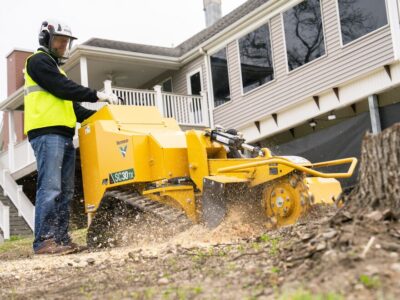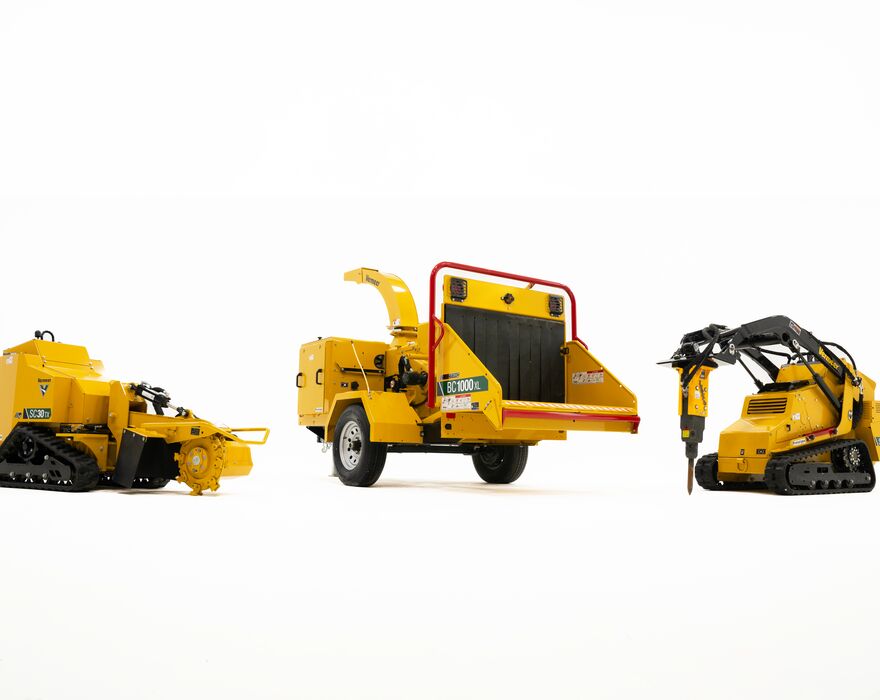Lower fuel costs, quieter operation and a competitive edge in a changing market
Operating a commercial gas-powered leaf blower for one hour emits as much smog-forming pollution as driving a car from Los Angeles to Denver, according to the California Air Resources Board. That’s one reason California and other states are phasing out small gas engines — and why more tree care and landscape professionals are exploring electric alternatives.
Vermeer is producing the brush chipper, mini skid steer and stump cutter as a solution for emerging concerns and regulations.
For those considering the shift, electric tree care and landscaping equipment offers more than just environmental benefits. It’s a strategic move that can improve operations, reduce costs and help win new business. Here’s how.
Reason No. 1: Electric equipment helps reduce operating costs in tree care and landscaping
Charging electric equipment at a shop or depot can significantly reduce fuel spend — especially for fleet owners.
“Your fuel cost is going to drop drastically,” said Josh Vrieze, senior product manager at Vermeer.
Electric machines also deliver instant torque, which improves performance in applications like stump grinding.
“There’s just a lot more torque and a lot more power available at the wheel on an electric stump cutter,” Vrieze said.
Reason No. 2: Quiet electric equipment gives tree care pros a competitive edge
Electric machines open up new hours and locations for work. “It almost sounds like a box fan running when you turn it on,” Vrieze said of the stump cutter.
“I would not have a problem going next to someone’s house at seven o’clock in the morning and starting that up. … I don’t think it would wake someone up.”
This matters in residential neighborhoods, near schools and in commercial zones where noise ordinances limit traditional equipment. According to the California Air Resources Board, small off-road engines like those used in landscaping equipment are a major source of localized air and noise pollution — and are being phased out in favor of zero-emission alternatives.
Reason No. 3: Electric tree care equipment requires less maintenance
Electric machines eliminate common pain points like engine oil changes and hydraulic contamination. With fewer moving parts, they’re easier to maintain — and easier to rent.
“There’s absolutely lower maintenance,” Vrieze said. “There’s not engine oil to change. There are fewer overall moving parts.”
The U.S. Department of Energy has noted that electric drive systems can cut maintenance costs and, when paired with smart charging, help reduce energy expenses — making them a cost-effective choice over time.
Reason No. 4: Electric tree care equipment aligns with climate-focused goals
Electric equipment also helps contractors align with broader sustainability and community goals — something that’s becoming more commonplace in municipalities, public agencies and companies. These priorities often include reducing emissions, minimizing noise and improving the overall health of the communities where work is being done.
“The tree care industry … they’re open to this, right?” Vrieze said. “But it needs to meet their needs. Maybe they have certain customers — whether it’s a utility company — that’s really pushing electric technology.”
That kind of customer expectation is becoming more common — and more valuable. According to the National Association of Landscape Professionals, electric landscaping companies are seeing increased demand, especially from clients who prioritize low-noise, zero-emission service. Some are even charging premium rates and winning more bids because of it.
For tree care and landscape professionals, adopting electric equipment can help meet bid requirements, strengthen customer relationships and position their business for long-term sustainability.
Reason No. 5: Global and domestic regulations are driving electric adoption
States like California are already phasing out gas-powered small off-road engines. California SORE (small off-road engine) regulations require most new engines under 25 horsepower to meet zero-emission standards starting in 2024. Other states are watching closely — and may follow suit.
Globally, the shift is just as clear.
The European Union’s Stage V emission standards are among the strictest in the world for non-road mobile machinery (NRMM), including landscaping and tree care equipment. These rules set tight limits on particulate matter and nitrogen oxides, pushing manufacturers and contractors alike toward cleaner technologies.
For tree care and landscape professionals, this shift isn’t just about compliance — it’s about readiness. Contractors who adopt electric equipment now can stay ahead of changing regulations and position themselves for long-term success.
That’s why the Vermeer approach to electrification goes beyond retrofitting. Their electric machines are purpose-built— designed from the ground up for performance, safety and reliability, with the same jobsite durability customers expect.
“We’re at the early stages here,” Vrieze said. “And that’s where I think Vermeer wants to be prepared — so that as this market continues to grow, we’re ready.”
Vermeer Corporation reserves the right to make changes in engineering, design and specifications; add improvements; or discontinue manufacturing at any time without notice or obligation.
Equipment shown is for illustrative purposes only and may display optional accessories or components specific to their global region.
Please contact your local Vermeer dealer for more information on machine specifications.
Vermeer, the Vermeer logo and Equipped to Do More are trademarks of Vermeer Manufacturing Company in the U.S. and/or other countries.
© 2025 Vermeer Corporation. All Rights Reserved.

